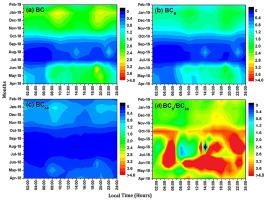Atmospheric Pollution Research ( IF 4.5 ) Pub Date : 2020-06-01 , DOI: 10.1016/j.apr.2020.05.024 M.P. Raju , P.D. Safai , S.M. Sonbawne , P.S. Buchunde , G. Pandithurai , K.K. Dani

|
Observations of Black Carbon (BC) aerosol concentrations were carried at Mahabaleshwar, a high altitude station in southwest India during March 2017–February 2019 using an Aethalometer (AE42) from Magee Scientific. BC concentration at Mahabaleshwar, varied from 0.016 μg/m3 to 16.03 μg/m3, with an average of 1.56 ± 0.88 μg/m3, indicating significant burden of these absorbing aerosols even at the free tropospheric altitudes (1348 m AMSL) as the station height remains above the Mixing Layer Height (MLH) throughout the year (MLH varies from 60 to 1293.6 m). BC is found to exhibit strong seasonal variation with the maximum concentration during winter and minimum during monsoon. The concentrations of BC, BC from fossil fuel (BCff), and BC from biomass burning (BCbb) exhibit diurnal variation with maximum values in the morning and evening hours and lower values around the afternoon due to the changes in the mixing layer height. The BCff and BCbb show the maximum value in winter (BCff: 1.47 μg/m3, BCbb: 0.69 μg/m3) which may be due to more biomass burning activity in the surrounding area along with the lower atmospheric temperatures and wind speeds which trap the pollution near the surface. However, in summer and post-monsoon the BCff remains around 1.0 μg/m3 and BCbb remains around 0.4 μg/m3. The lowest values of BCff (0.47 μg/m3) and BCbb (0.15 μg/m3) are exhibited in monsoon. Large negative radiative forcing was observed at the surface (SUF) and at top of atmosphere (TOA) whereas that at the atmosphere (ATM) was positive during all the seasons for both composite aerosol and without BC scenarios thus inferring to the significant cooling at SUF and warming at ATM leading to high atmospheric heating rates. Overall, the contribution of BC to the total atmospheric aerosol radiative forcing (ARF) was found to be 43% for the whole observational period. Temporal variations of MLH, BCff, and BCbb along with meteorological parameters and bivariate analysis of winds with respect to BC have been also discussed.
中文翻译:

Mahabaleshwar高原站上的黑炭气溶胶:辐射强迫和源分配
2017年3月至2019年2月,在印度西南部的一个高空站Mahabaleshwar上,使用了Magee Scientific的Aethalometer(AE42)对黑碳(BC)气溶胶浓度进行了观测。BC浓度在默哈伯莱什,从0.016微克/米变化3到16.03微克/米3,平均为1.56±0.88微克/米3,这表明即使在自由对流层高度这些吸收气溶胶显著负担(1348米AMSL)作为全年站高都保持在混合层高度(MLH)以上(MLH从60到1293.6 m不等)。据发现,卑诗省表现出强烈的季节性变化,冬季最大浓度,而季风最小。化石燃料中BC,BC的浓度(BC ff),生物量燃烧产生的BC(BC bb)表现出昼夜变化,早晨和晚上的时间最大值,而由于混合层高度的变化,下午左右的值较低。BC ff和BC bb在冬季表现出最大值(BC ff:1.47μg/ m 3,BC bb:0.69μg/ m 3),这可能是由于周围地区的生物量燃烧活动增多以及大气温度较低和风速将污染物捕获在地表附近。但是,在夏季和季风后,BC ff保持在1.0μg/ m 3左右,BC bb保持在0.4μg/ m 3左右。季风中的BC ff(0.47μg/ m 3)和BC bb(0.15μg/ m 3)最低。在复合气溶胶和无BC情况下,在所有季节中,表面(SUF)和大气顶部(TOA)均观察到较大的负辐射强迫,而大气(ATM)的正辐射强迫为正,因此推断出SUF的显着降温以及在ATM机上变暖导致大气加热率高。总体而言,在整个观察期内,发现BC对总大气气溶胶辐射强迫(ARF)的贡献为43%。MLH,BC ff和BC bb的时间变化 还讨论了有关BC的气象参数和风的二元分析。



























 京公网安备 11010802027423号
京公网安备 11010802027423号